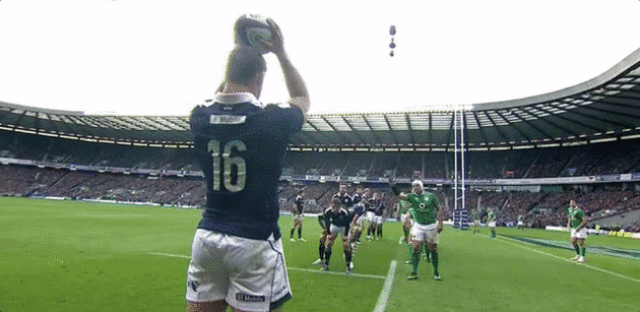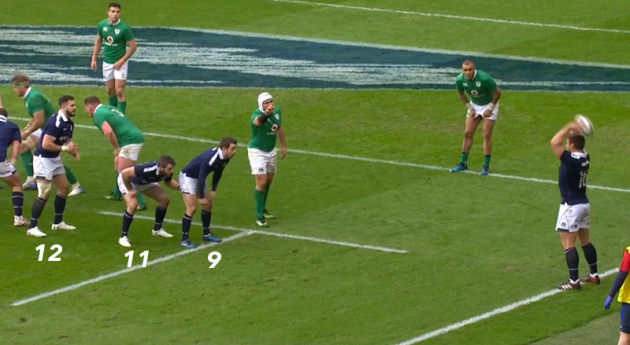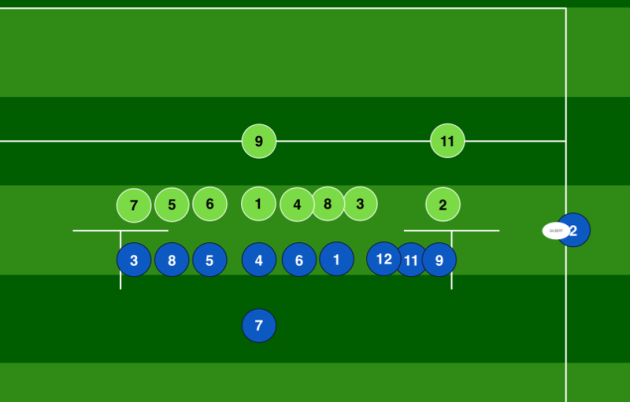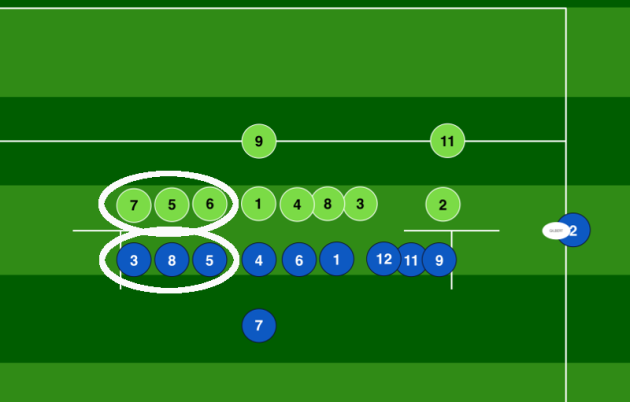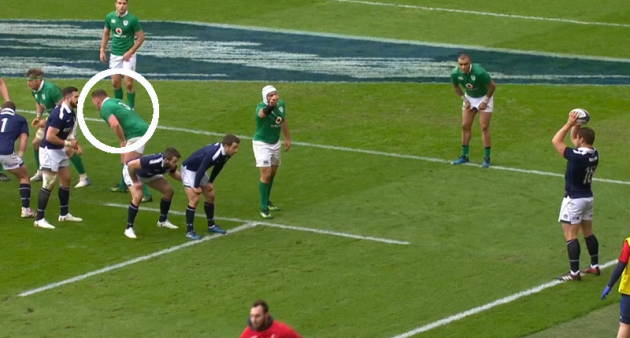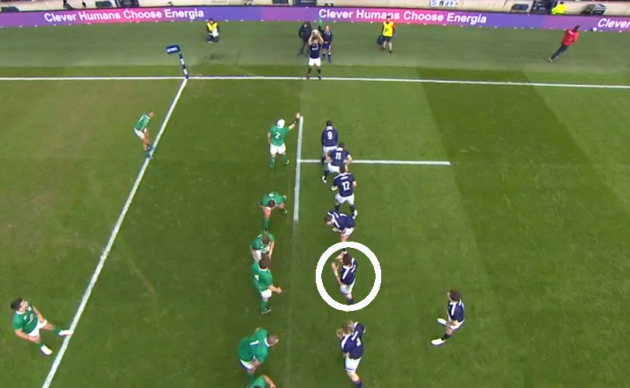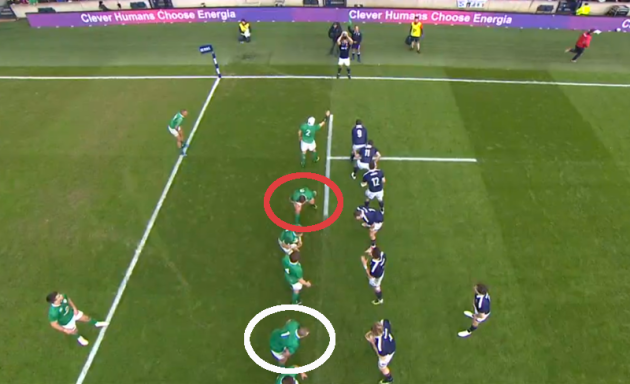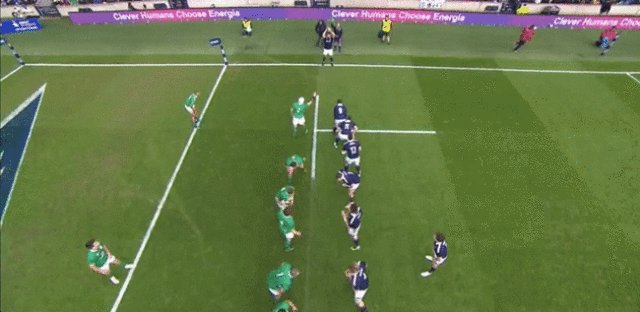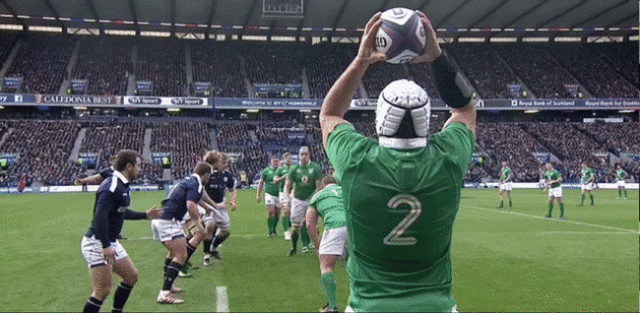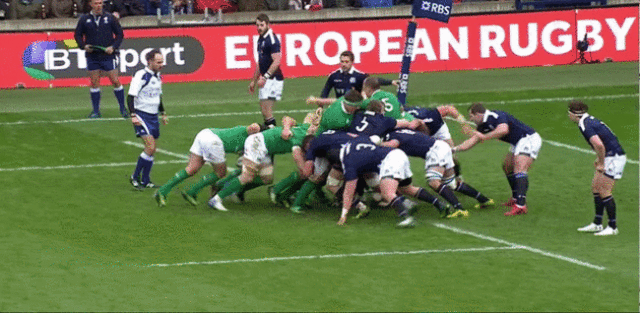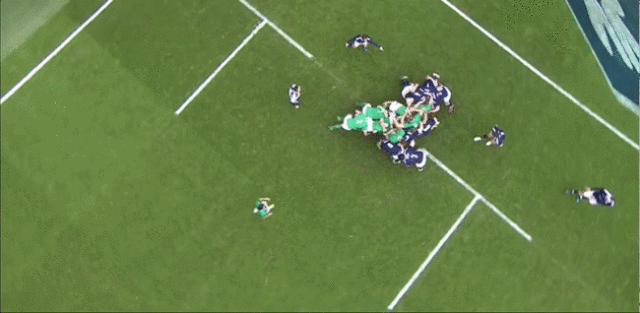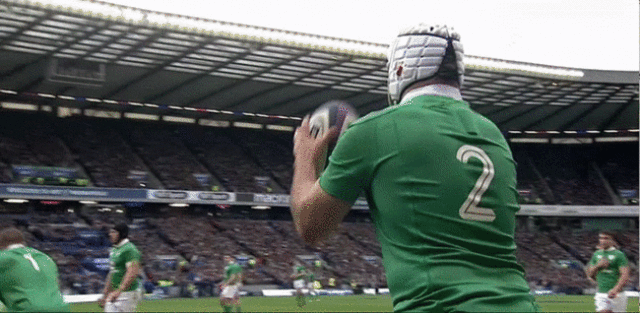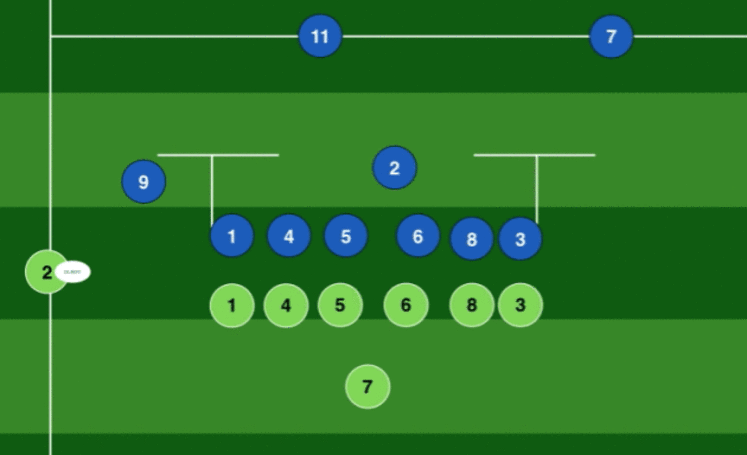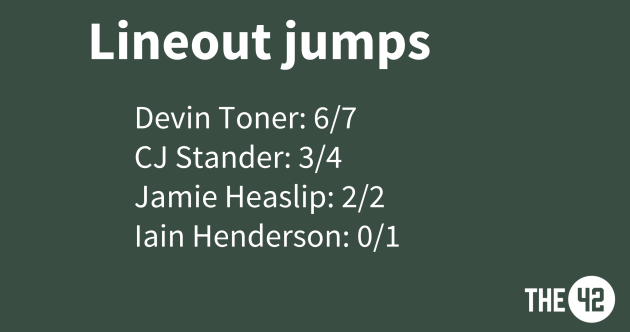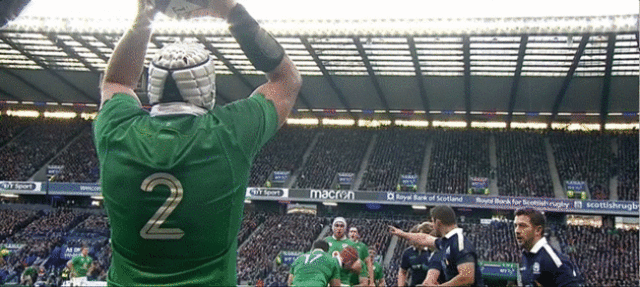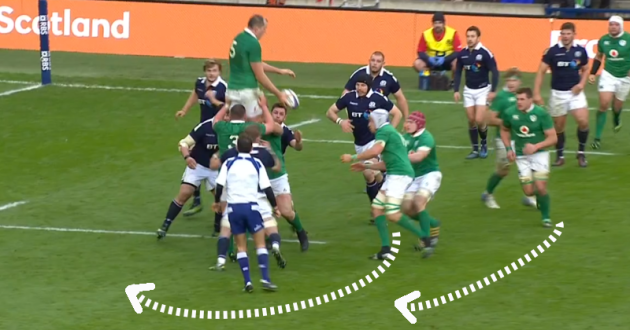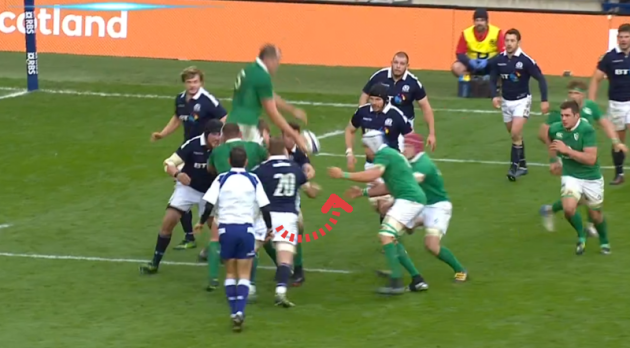ALEX DUNBAR’S LINEOUT try for Scotland on Saturday rather perfectly summed up much of the Irish performance in Murrayfield.
Distracted, unresponsive, muddy in thought.
We’ve already examined how Ireland’s poor mental state affected their defensive display, but we also saw strong signs in a lineout and maul performance that was very damaging.
The try by Dunbar – a centre – at the lineout was the lowlight in these shortcomings.
As with our analysis of Ireland’s defensive failings, we must point out that Scotland are superb here. It’s a highly-intelligent trick play that has clearly involved a large amount of analysis work and took genuine balls to call.
If this one goes wrong five metres out from the opposition tryline, there’s great scope for ridicule. Instead, Scotland lineout caller Jonny Gray makes a simple and informed decision to allow the Scots take a commanding 21-5 lead with 30 minutes played.
Key to the move is, of course, the presence of backs at the front of the lineout.
We can see above that scrum-half Greig Laidlaw [9], right wing Tommy Seymour [11] and inside centre Dunbar [12] are part of the lineout.
But the camera angles from Saturday’s game don’t give us the greatest idea of what’s going on further back in the lineout, so it’s worth plotting that out ourselves.
Below, we can see a representation of how both teams are set up before replacement hooker Ross Ford’s throw.
Scotland have nine players in the lineout to Ireland’s eight, so it’s not exactly as if there is a huge overload that Joe Schmidt’s men simply can’t cover.
But Ireland fail to cover the spaces as best they might have.
They are well positioned to defend a throw to the tail, with Sean O’Brien [7], Devin Toner [5], and CJ Stander [6] in a position to either get up and compete or engage in a maul if Scotland’s Josh Strauss [8] is lifted by Zander Fagerson [3] and Jonny Gray [5].
Closer to the touchline, we can see that Ireland have a pod ready to cover a throw to the middle of the lineout, with Jack McGrath [1] and Jamie Heaslip [8] in position to lift Iain Henderson [4] if Scotland hit Ryan Wilson [6].
That much is indicated below.
Of course, there are several other lifting and jumping combinations possible for Scotland if they perform pre-throw movement on the ground and re-shuffle their ordering, but in the most basic terms these two ‘pods’ match up well for Ireland.
Jack McGrath [1] obviously isn’t a realistic defensive jumper up against Richie Gray [4], but even if there isn’t going to be an Irish jump to compete they are well set to contest the Scottish maul in this area.
The problem is closer to the touchline, where Tadhg Furlong has turned his back on those three backs.
Furlong – like the rest of the Ireland pack – clearly expects the Scots to throw to the middle or tail and then fire up a nine-man maul.
Generally, that’s what we get when backs join the lineout and we’ve seen examples of that kind of tactic from the likes of Connacht, the All Blacks, Wales and Ireland themselves in recent years.
But there is still a requirement to mark the spaces and Ireland leave a glaring hole at the very front of the lineout.
Making Furlong’s positioning all the more frustrating for Ireland is the fact that Wilson [circled below] is the first realistic Scottish jumper in the original lineout set-up.
Wilson is, therefore, the first man in the set-up who could possibly be lifted – before any possible movement pre-throw – so Furlong would not even be needed to lift a competing Irish jumper against Wilson.
Of course, Wilson could swap places with with Allan Dell in front of him and jump from there, but that would require inside centre Dunbar lifting him from the front. Another unlikely scenario.
The shortcomings from Ireland are obviously collective and they need to be far better organised on defensive lineouts, but a simple repositioning from Furlong would have prevented the try in this case.
We can see above that McGrath [in white] is facing the Scotland lineout and giving himself options to turn towards the touchline and lift there, or turn back infield and lift towards the back of the lineout.
Furlong [in red] – presuming that the backs at the front of the lineout are not realistic targets – simply has his back turned and gives himself no flexibility.
Captain Rory Best at the front, meanwhile, is relatively slow to react when Ford’s throw hits Dunbar and the damage is done in the blink of an eye.
Ford’s throw might be ever so slightly towards the Scottish side of the lineout, but it’s certainly not as bad as some we see in the game today, while Ireland’s feed to the scrum was consistently crooked and unpunished.
It’s an excellent score by Scotland, cleverly designed, but Ireland will be embarrassed by the ease of it.
Early failings
Ireland won 12 of their 14 throws into the lineout on Saturday, but the losses were extremely costly and some of those ‘wins’ provided scrappy possession for Ireland.
We’ve already taken a look at how Scotland scored their first try through Stuart Hogg, but it’s worth underlining that Vern Cotter’s men were given the chance to grab the territory for that try because of a lineout error from Ireland.
The incident below comes in the sixth minute of play, with the score still at 0-0 and Ireland in a fine position to build pressure on the Scots.
The movement from Ireland pre-throw is good, the lifting from McGrath and Heaslip is strong, and it all leaves Henderson in a position to take clean ball in the middle of the lineout.
But the Ulsterman drops the ball at the apex of his jump, a simple handling error. Henderson is likely distracted by the jump of Jonny Gray at the front of the Scotland lineout and perhaps the flight of Best’s throw is not perfect, but Henderson will still feel he should have held this ball.
Instead, Scotland pounce on the loose possession, counter attack, and eventually score the opening try just over two and a half minutes later.
Timing off
Jump to the 13th minute, with Ireland now 7-0 down, and they have a superb opportunity to bring themselves rapidly back into the game. A penalty against Scotland’s Wilson for going off his feet at ruck time allows Ireland to kick up into the left corner.
Their first maul is illegally collapsed by Scotland – this is an issue that referees need to focus more attention on. Last year, Ireland had five almost certain maul tries collapsed by the opposition.
Nonetheless, they go to the corner again with the second penalty in this instance and construct another maul after Toner catches Best’s throw in the middle of the lineout.
Saturday’s theme of Ireland being unresponsive or slow to react raises its head again here, however, as they are called up for accidental offside ahead of the ball carrier.
The maul is strongly set up by Ireland but they simply must react more swiftly when they break off to the left. Heaslip suggests to referee Romain Poite that it’s “still the same lineout” – i.e. Scotland have disengaged from the maul and Ireland can therefore continue forward as they do – but Poite has clear grounds for his decision.
As Heaslip, McGrath and Best shear off to the left, there needs to be a call from someone – Best, McGrath, Heaslip or even Conor Murray – to ensure ball carrier Best disengages from McGrath and Heaslip in front of him.
With Scotland scrum-half Laidlaw exposed to the left of Ireland’s maul, Best would likely have made good headway in a one-on-one, if not barrelled all the way to the tryline.
Instead, Ireland are called up and the opportunity to strike back at Scotland on the scoreboard is missed.
There have been several suggestions that Ireland should have used the two penalties mentioned above to scrummage against Scotland – given their early advantage in this department – but as we’ve underlined only recently, the close-range lineout maul is the try-scoring strength of this Ireland team.
For them to back their maul from this distance made sense at the time.
Picked off, punished
We’re in the 19th minute of this game now, with Ireland still trailing 7-0 and a scrum penalty against Zander Fagerson having allowed Jackson to kick them back up towards the left corner. Another prime scoring chance.
But 10 metres or so from the Scotland tryline, Ireland get picked off.
Our camera view of the lineout isn’t fantastic, but we can see that Toner moves from the middle of the set-up to the front in the hope of taking the ball there.
The problem is that Scotland are well set up to defend it and they also read Ireland’s plan accurately.
We can see the initial set-up above, with Ireland opting for a six-man lineout, with Sean O’Brien acting as the ‘receiver’ in behind the lineout, ready to accept a transfer of the ball and most likely steer an Ireland maul forward.
Ireland’s pre-throw movement sees Henderson [4] shift in behind Toner [5], with Toner coming forward with back lifter Stander [6] to link with front lifter McGrath [1].
But we can see that Scotland have an excellent defensive jumper in that area in the shape of Richie Gray [4], and himself and brother Jonny [5] both read Ireland’s calling intuitively.
They back their belief that Toner will call this crucial lineout to himself and they are in the perfect position to pick it off.
Less than two minutes later, Scotland score their second try through Hogg.
As for the first try, Ireland’s lineout failure is deeply damaging.
It’s interesting to note who Ireland threw to in the lineout on Saturday. We pointed out before the game that there was some concern that teams would increasingly target Toner, the key man in so many of Ireland’s lineout tries – which they score plenty of.
Below is a list of Ireland’s targets in the lineouts at Murrayfield. It’s worth noting that we marked one Stander take as a lost lineout, as Scotland pored through and reclaimed a lose ball on the Irish side of the lineout.
Clearly, Toner is always going to be target number one for Ireland. He’s tall and has good handling skills, making him an obvious catcher.
Stander has often been Ireland’s second jumping option in recent times, as our try analysis reflected, but it’s most interesting to note the lack of times Ireland used Henderson as a jumper against the Scots.
The Ulsterman is more noted for his ball-carrying and collision prowess than his set-piece ability and it did seem as if Ireland were hesitant to use him as a jumper after his early missed catch.
Stander and Heaslip are both solid lineout options, but it does appear that Ireland are lacking the very highest calibre of lineout options aside from Toner.
Back when Ireland won the 2014 Six Nations under Schmidt, we analysed the sheer quality of their lineout, when Paul O’Connell, Toner and Peter O’Mahony all provided world-class jumping options.
The defensive lineouts against Ireland had so much to worry about and the Irish movement on the ground was sublime. Ireland don’t have O’Connell anymore obviously, but O’Mahony has been badly missed at the lineout, as well as in some other areas.
Naturally, there are more things than the lineout to consider when selecting a team, but it will be fascinating to see how O’Mahony is used by Ireland when he returns to fitness.
Donnacha Ryan was unlucky to miss out on selection for the Scotland clash and it will also be interesting to note if Schmidt brings him in this weekend in the hope of adding a greater lineout threat for Ireland.
As we’ve noted before, 12/14 – 85% – is not the worst return, but when we take into account the lineout turnover from a throw to Stander, Ireland’s percentage sinks to 78%.
There is certainly real room for improvement here.
Scotland superior
We’ve seen how Irish failings contributed closely to the Scots surging into their 21-5 lead, but even after Ireland got back into the lead in this game there was a key miss from a close-range lineout.
Below, we’re in the 68th minute and Ireland lead 22-21. A chance from 10 metres out is a clear opportunity to finish this game.
Whatever about the missed opportunities from linebreaks at Murrayfield, the below scenario is the kind of platform Ireland’s game is built on. This is the chance they must take.
Keen to avoid getting picked off again, Ireland now go for something very different as they throw beyond the 15-metre line to Toner, lifted by Healy and Furlong.
The intention appears to be for Toner to transfer the ball to replacement Ultan Dillane, who will thunder away infield where he will be running directly at Scotland out-half Finn Russell.
There is also potential for Dillane to spin and hit Stander coming around the corner at high speed.
Scotland, however, are brilliant in their response – such a contrast to Ireland’s non-reaction for the Dunbar lineout try.
The Scots have been hurt by Ireland with a lineout throw over the 15-metre line in recent years, with Sean O’Brien scoring from an old Schmidt Leinster trick play in the 2015 clash at Murrayfield.
So this time, Scotland are tuned in and aware of the circumstances, even if Ireland’s planned move is different on this occasion.
In plain terms, once the ball goes beyond the 15-metre line, the lineout is over.
Replacement Scotland back row John Barclay understands that and uses it to his advantage as he swings in behind Toner, rather than looking to engage in a maul situation.
While Barclay is moving into that space, it’s also notable that Jonny Gray tackles Cian Healy to the ground – keen to ensure there is no repeat of that O’Brien try in 2015.
Barclay is dynamic in his actions as he battles in onto the ball, but Dillane and Stander simply have to do better in this instance.
While the Scotland back row gets into a good position, Dillane is realistically still in control of the ball.
Rather than accepting that the lineout move is not going to work out as planned and looking to secure the ball, Dillane and Stander get muddled somewhere between the second row keeping it and the blindside flanker taking it from him.
In the end, it’s a poor knock-on and Ireland miss their opportunity. They fail to return to the Scotland 22 for the remaining 10 minutes or so of the game and slip behind Scotland as Laidlaw seals the home side’s victory with two penalties.
It’s glaring how costly Ireland’s lineout and maul failings were in Murrayfield and, if they are to claw back into the Six Nations race, they need to rapidly rediscover their clinical touch in what has previously been a strength of their game.
Forwards coach Simon Easterby and his pack have some important work to do.
Subscribe to The42 Rugby Show podcast here:
